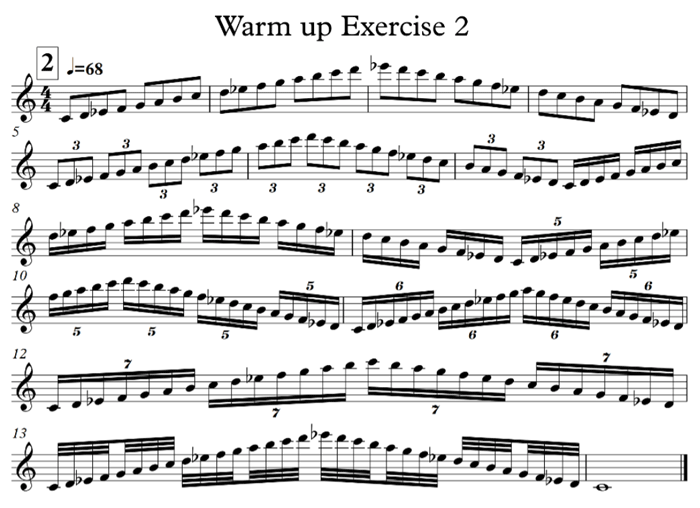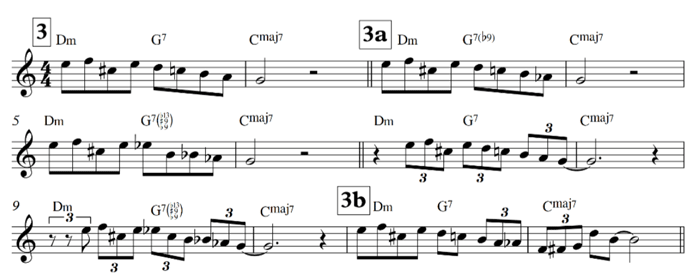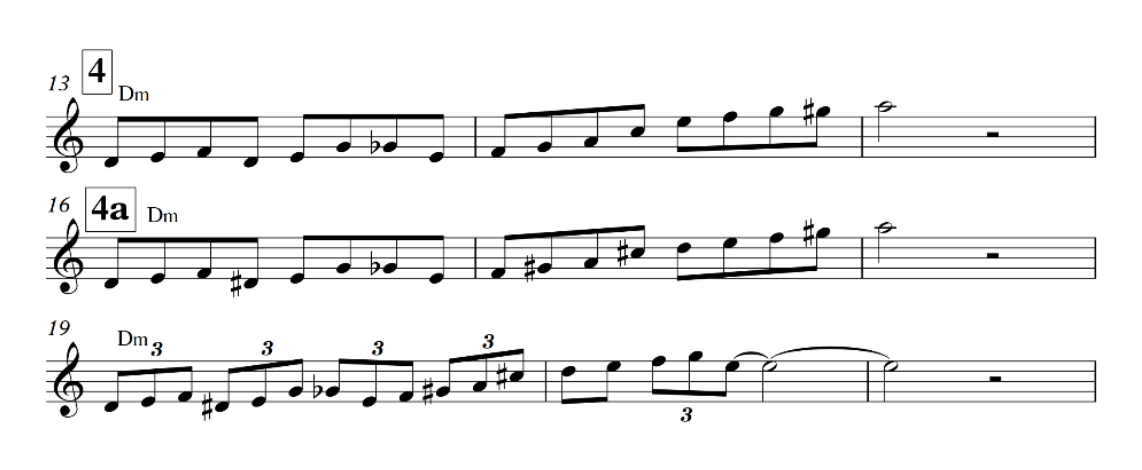A 5-Part Practice Routine for the Improvising Saxophonist
I this article, I’d like to share some specifics on two regular fixtures from my practice routine – warm ups and creating lines.
Warm Ups
#1: Body Wake Up
I first try to ‘wake up’ my body with this exercise. I put almost-exaggerated air and body support on the notes marked with articulation, which makes me aware of what a physical instrument the saxophone is.
Can be played up/down through the whole register.

#2: Rhythmic Wake Up
This one is more aimed at practicing rhythm.
The metronome should be slow (around 60bpm) and the exercise performed over the whole register, changing the subdivisions from 1/8 to 1/32 – through triplets, 1/16 etc.
It can be whatever scale you prefer to practice, and you run through the whole register choosing where to make the ‘turn’ in the top.
It’s also possible to start with quarter notes, then quarter triplets before the 1/8’s…

Creating Lines
Next I practice something I’d call “an explorative approach to creating lines.”
I pick up a certain line that I like – usually something I have heard in someone else’s solo playing. Then, instead of just learning and using it as it is, I tend to be creative with the lines I pick up. I’m exploring the possibilities and trying to be flexible using the material/elements that I hear within the line.
#3 Short lines
One example would be this very simple and well-known line (3)
I’d then try to alter certain notes in the line and then change the rhythm too (3a)
Then I’d practice starting the original line but continuing the line in a different way (3b)

#4 Longer melodic lines
I’d then repeat this exercise, but using longer melodic lines as a starting point (4)
Again, you can see the ways you could alter things both in terms of notes and rhythms (4a)

#5 Moving Lines around
I then like to use these simple lines and to combine them with certain patterns, specifically, moving certain structures around.
If you identify a simple pattern from your own practice and then experiment with the different ways of moving it around. For example, in line 1, the pattern of a 1/2 step + minor third is here moved around chromatically.
Then, you can experiment with using the pattern as part of your own, improvised line.
Here I use the pattern as point of departure while the line ends in a more traditional melodic line.
I elaborate quite freely over the original line from exercise #4 (Longer melodic lines) using the structure from the first 6 eight notes.
And of course I need to have some good target notes placed here and there on down beats (beat one of third bar for instance, and the very final note as well).
Because of the chromatic approach from the chosen pattern, I also combine both minor and major thirds in the line.
As you’ll see, the examples here make use of the shape from the first part of the line from exercise #4

As I’m sure you can see, there are an almost unlimited number of possibilities/exercises you could end up with by working through these methods! It’s an approach I like to use when practicing how to improvise on certain tunes. It inspires my imagination and helps with developing my flexibility.
This approach can of course also be used when composing melodies in general and be adjusted to explore other things like modes, colors and expressions as well as notes and rhythms.
I hope some of these ideas will be useful in your own quest for that perfect practice routine!
Pernille Bévort’s Saxophone Set-up
- Tenor saxophone: Selmer M6 from 1962 with a Morgan Jazz M/L n.7 mouthpiece, hard rubber (I recently changed from a Selmer Super Balanced Action from 1949, with silver body)
- Reeds on tenor: D’Addario, Select Jazz, Filed, 3 soft
- Soprano saxophone: Selmer Series III – Selmer Mouthpiece E from the 80’s (rubber)
- Reeds on soprano: Vandoren Blue 2,5
- Both with Marc Jean Ligatures especially made for Morgan
Where to find more from Pernille:
– www.pbevort.dk
– https://www.facebook.com/pernillebevortmusic
– https://open.spotify.com/artist/1Y1qQvf0rRxHFB1H0VSNCV?si=Ze9AvCPzS1GdlJ9C-GCfhg
– https://www.youtube.com/watch?v=UP8blC8tAd4







October 6, 2022 @ 9:57 am
Can I print these exercises out somewhere
October 6, 2022 @ 10:31 am
Hi Curtis.
I would try to take screen shots for instance?
Otherwise go to my website: http://www.pbevort.dk
Under contact you find my mail. Write to me.
I have them on my computer – can send to you :)
How Do I Improvise on the Saxophone? Essential Tips for Jazz Beginners - PlayWoodwinds
December 22, 2024 @ 7:42 am
[…] Backing tracks provide a practical way to practice improvisation without a live band. They allow saxophonists to focus on their own playing while maintaining a sense of rhythm and harmony. […]